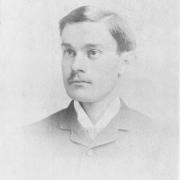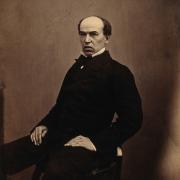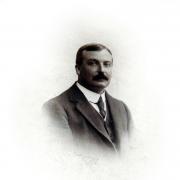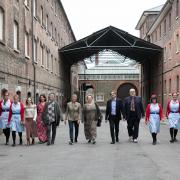It's played a role in Canterbury's turbulent history for more than 600 years. Now a businessman with a love of history believes unique Westgate could be a vital part of the future as the city fights the downturn. Read here to find out more . . .
Tower of strength
Go to jail. Go directly to jail. That’s Charles Lambie’s message to Canterbury residents and visitors. It appears to be a strange request from someone committed to improving the ancient city’s economy through its tourism.
So let’s look at it again. Go to gaol is a more accurate way of putting it. More specifically, he wants people to go to the two historic gaols now in his charge. One is the grimly imposing Westgate Towers, the largest medieval gatehouse in England, described by Charles as the most iconic building in Canterbury after the cathedral. The other is the former Victorian prison next door to the Towers and linked to them by a high-level bridge.
With more than five centuries of history wrapped up in their grey ragstone walls alongside the River Stour, the two buildings have intriguing stories, including the very birth of law, order and government as we know it. They involve rebellions, executions and indescribable squalor and torment, as well as the defence of Canterbury against the recurring threat of invasion. Charles Lambie, a property investor and chairman of the Trustees of Canterbury Archaeological Trust, is investing a sizeable sum of his own money into unwrapping these unusual Canterbury tales for public consumption.
The Towers museum re-opened this month on a daily basis and shortly, after almost a year of preparation, the Victorian gaol will open to visitors. Helping is Dunstan, a cartoon rat, designed to guide visitors through the twists and turns of the gaols’ timeline and named after the city’s medieval area.
Charles says the challenge for him was to ensure that his customers have a fascinating and memorable experience, can get a decent cup of coffee and something to eat and feel they have had excellent value for a very affordable price (�6 for an extended family ticket, which can include mum, dad, grandparents and the kids).
“There is fabulous raw material to work with,” he says. “After all, the Towers were the Trident missile of their time and very advanced. They had round towers designed to deflect gunfire, murder holes through which boiling oil or stones could be dropped on attackers and potentially some of the earliest gun loops in England. “And, of course, visitors can enjoy the best view there is of Canterbury from the top of the 60ft towers.” It all fits with his philosophy that a sound commercial future for Canterbury lies in its historical past.
Charles breathes history. The mantlepiece of his home, a restored former mill house just over the river from the Towers, is covered in artefacts collected while walking beside the river. They include a flint axe head and a flattened musket ball, possibly fired at Westgate during the city’s riot of 1648, when Cromwell tried to ban Christmas celebrations. He believes that if Stonehenge can attract a million visitors a year then Canterbury, with so much to offer, should manage more than its current estimate of 1.3 million.
“My absolute passion is Canterbury and its rich heritage. This creates an historical environment that should be the compelling reason for attracting residents, businesses and visitors to come here,” he says.
“I am delighted to say that I am not alone – there is an understanding and recognition that this is the case. There needs to be a palpable sense of warmth and welcome to the city to ensure that visitors and residents can truly enjoy Canterbury and all it offers. It will work.”
Charles literally put his money where his belief is when the Westgate area appeared to be heading for stagnation or worse. The old and neglected Victorian gaol building in Pound Lane, then being used as a music school, was made available by owners Kent County Council in 2007. Conditions of the purchase involved refurbishment of the sadly neglected building. He bought it. Subsequently Kent Music School, one of the tenants, sought to surrender its lease. Last year the city council considered closing the Westgate Towers’ museum as part of its 2011 spending cuts. The opening hours had already been substantially reduced. Charles took a 40-year lease. The stage was set.
He admits to spending a six figure sum on building work, mainly restoring the Victorian gaol, including the construction of a large glass box on the York stone exercise area for a caf�. The bridge linking the two buildings will also be encased in glass, following lengthy discussions with English Heritage. He is also discussing changes to the roof of the Towers to make the spectacular viewing point more suitable for visitors. Part of the Pound Lane building, earmarked to eventually become an apart-hotel, continues to be occupied by Canterbury Christ Church University’s music school. At 11am on Fridays musicians will sound a fanfare from the top of the Towers, another compelling reason to persuade people to sample the Canterbury experience.
Just before we part company I use the first-floor bathroom at his home. And there, framed in the window, is a perfect view of Westgate Towers. Stunning.
Charles Lambie
Charles Lambie went to the University of Kent in Canterbury and has had a home in the city since 1983. He runs Cranmer Investments, a commercial property investment and development company, and is a former managing director of The Milton Group, a Sevenoaks-based commercial property investment company. He joined the Trustees of Kent Archaeological Trust in 2000 and became chairman in 2005. He includes palaeontology among his interests along with the Cherokee Indians, cricket, walking and shooting. A fascination in coinage and the Canterbury mint is behind the design of the logo for his Westgate project.
The Westgate story
300 AD: The Romans walled Canterbury and created the first west gate1379: Current Westgate Towers built at a time of threatened French invasion. It was one of seven medieval gateways but, as it was on the London Road, it was the city’s most important1381: Archbishop Simon Sudbury, who ordered the Towers to be built, murdered in Peasants’ Revolt1450: Head of Bluebeard the Hermit displayed over Westgate. He was executed for involvement in Jack Cade’s rebellion of Kent and Sussex men over corruption and taxation 1648: Oliver Cromwell’s Parliamentarians burned the gates to Westgate when they came to Canterbury to quell riots over banning of Christmas Day
15th-19th centuries: the Towers were used as Canterbury’s city gaol. Felons and debtors, men, women and occasionally children were housed there. Poor security meant felons were fettered. Begging box at street level where prisoners could plead for sustenance1812: State of the Prisons report described Westgate as unhygienic with inadequate sanitary facilities. Recommended action: immediate fumigation with vinegar1815: Last recorded execution at Westgate gallows1820s: Continuing concern over inadequacies of gaol and, in particular, risk of “moral contamination” due to lack of segregation. Demolition of Towers considered for traffic improvement scheme 1823: Plans submitted for new gaol 1830: Pound Lane gaol opened. Designed by City Architect John Cooper to fit in with West Gate Towers, which continued to house debtors. Old “dayroom” converted to chapel. Cost of �3,500 caused concern among local taxpayers1865: Failed to meet requirements of Victorian Prison Act and closed the following year after being used as gaol for less than 40 years1869-1965: Pound Lane building used as the city police station1869: Gaol opens as city police station. Old Gaoler’s House became chief constable’s family home1870: Council took back Towers for storage1878: Visitors allowed in to Towers as “summer season experiment”
1906: Towers opens as a museum1930s: Plan to move overcrowded police station to new Civic Centre site shelved because of war threat1939: Air-raid siren sited on Towers.1940: Observation post on roof1941: Medieval tower set up as fortified house in “Fortress Canterbury,” part of plan to repel or delay invading Nazi forces 1944: Westgate features in famous Powell and Pressburger film A Canterbury Tale continued in use as police station until 19651965: Pound Lane police station closes1966: Edward Heath, then Conservative Party leader, opens East Kent Music School in old police station.


























